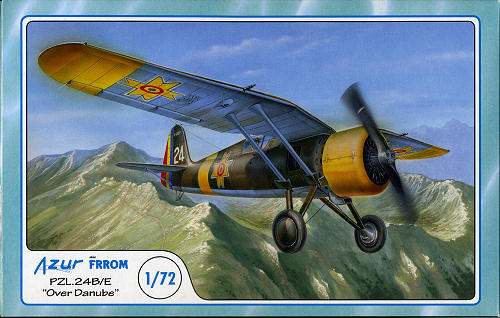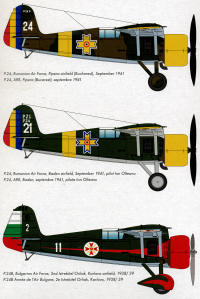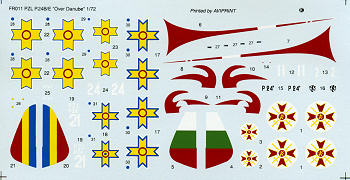
Azur/FRROM 1/72 PZL P.24B/E "Over Danube"
| KIT #: | FR011 |
| PRICE: | CDN $27.00 from www.westcoasthobbys.com |
| DECALS: | Three Options |
| REVIEWER: | Scott Van Aken |
| NOTES: | Includes photo etch fret and resin parts |

| HISTORY |
The PZL P.24 was developed as an export version of the PZL P.11, a gull-wing all-metal fighter designed by Zygmunt Puławski. The P.11 was powered with a license-built Bristol Mercury engine. The license did not permit export sales, so the French Gnome-Rhône company proposed using their engines in the P.11. The first P.24/I prototype, based on the P.11a and powered by a Gnome-Rhône 14Kds 760 hp (570 kW) engine, was flown in May 1933. The second P.24/II prototype, named the "Super P.24", set a world speed record for radial engine-powered fighters (414 km/h). The third P.24/III prototype was the "Super P.24bis" with a more powerful 14Kfs engine. The type was shown at the Paris air show in 1934 attracting great interest from the participants.
The aircraft was conventional in layout, with high wings. It was all-metal and metal-covered. The wings had a gull-wing shape, with a thin profile close to the fuselage, to provide a good view for the pilot. This configuration was developed by Zygmunt Pulawski and called "the Polish wing". The canopy was closed (apart from prototypes). An internal 360 liter fuel tank in the fuselage could be dropped in case of fire emergency. It had conventional fixed landing gear, with a rear skid.
The armament was a combination of 20 mm Oerlikon FF cannons and 7.92 mm Colt-Browning machine guns in the wings.
| THE KIT |
 There
have been several P.24 kits in 1/72 from a variety of manufacturers in both
injected plastic, resin and vacuformed plastic. Your editor built one of
unknown origin
20 or more years ago that was rather crude, to say the least.
There
have been several P.24 kits in 1/72 from a variety of manufacturers in both
injected plastic, resin and vacuformed plastic. Your editor built one of
unknown origin
20 or more years ago that was rather crude, to say the least.  popular
French engine of the time and powered a staggering number of aircraft,
including several wartime German planes such as the Hs-129.
popular
French engine of the time and powered a staggering number of aircraft,
including several wartime German planes such as the Hs-129.  rrugations
do not extend over the wing leading edges. I also noticed that there are no
pushrods on the engine, nor do the instructions show these needing to be
added. It will add a lot to the engine if these are added; at least to the
front row, but it is your choice. This would have been a nice p.e. or resin
addition.
rrugations
do not extend over the wing leading edges. I also noticed that there are no
pushrods on the engine, nor do the instructions show these needing to be
added. It will add a lot to the engine if these are added; at least to the
front row, but it is your choice. This would have been a nice p.e. or resin
addition.  ded
is clearly shown as are any optional bits. The gear legs will require some
rigging so be aware of that need. The markings are provided for three
aircraft. One is a pre-war Bugarian AF version with a large red speed stripe
and cowling in Dark Green over Light Blue. The two Romanian versions are
quite similar in Dark Green and Dark Earth over Light Blue. These both carry
Eastern Front markings consisting of a yellow fuselage band, lower wing tips
and cowling. The big difference is the style of insignia. The decals are
superbly printed; very crisp and in register.
ded
is clearly shown as are any optional bits. The gear legs will require some
rigging so be aware of that need. The markings are provided for three
aircraft. One is a pre-war Bugarian AF version with a large red speed stripe
and cowling in Dark Green over Light Blue. The two Romanian versions are
quite similar in Dark Green and Dark Earth over Light Blue. These both carry
Eastern Front markings consisting of a yellow fuselage band, lower wing tips
and cowling. The big difference is the style of insignia. The decals are
superbly printed; very crisp and in register.| CONCLUSIONS |
If you are a fan of these aircraft or just want a nicely done kit of a semi-obscure central European air force, then I can easily recommend this one to you.
| REFERENCES |
http://en.wikipedia.org/wiki/PZL_P.24
September 2011
Thanks to
www.westcoasthobbys.com
for the preview kit. Order yours today.
If you would like your product reviewed fairly and quickly, please
contact
me or see other details in the
Note to
Contributors.